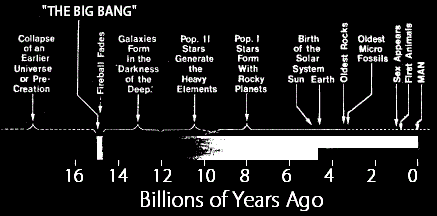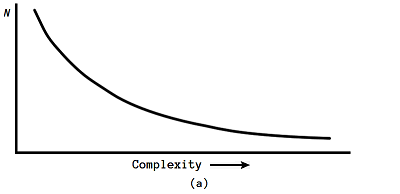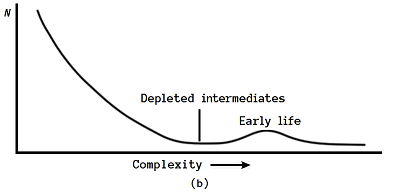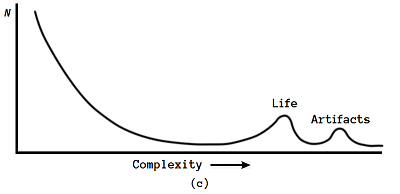© 1979 Robert A. Freitas Jr.
All Rights Reserved
| The ubiquity of life |
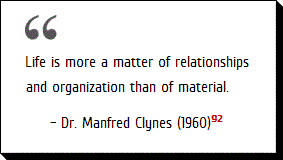 In earlier chapters we considered the astronomical environment which extraterrestrial lifeforms must cope with. Other galaxies, stars, and countless planets appear amenable, if not perfectly hospitable, to life.
In earlier chapters we considered the astronomical environment which extraterrestrial lifeforms must cope with. Other galaxies, stars, and countless planets appear amenable, if not perfectly hospitable, to life.
Since no ETs have been detected outside the Earth to date, it might be argued that any statements regarding the ubiquity of life in the universe must necessarily be pure speculation. But this is not so. We have the incredibly good fortune to be alive at the first moment in history when this tantalizing question can be approached with rigor and in some detail.20 Not only can we draw certain tentative conclusions regarding the existence of extrasolar planetary systems, but we may also seriously discuss whether or not other worlds will possess environs which permit, encourage, or demand the emergence of life.
It is probably true that a good many planets are merely dead bodies of rock washed by sterile seas.939 Much depends on whether life originates quickly and regularly given suitable conditions, or if it requires an event so improbable that evolution in any reasonable time is scarcely possible on any world.
| Abiogenesis |
The study of the origin of life, called "abiogenesis" by many researchers in the field, is highly relevant to xenology and xenologists. By determining the conditions that existed on the primitive Earth, and by duplicating them in the laboratory, scientists can attempt to recreate events that must have occurred on this planet billions of years ago. Should these experiments indicate that the fundamental chemical building blocks of life are easy to generate — perhaps even inevitable under the proper circumstances — then we might well be justified in concluding that biology is a fairly widespread phenomenon among the many worlds of the Milky Way.
Studies in abiogenesis give some clues as to the universality of those processes which lead to the emergence of life. Of course, any rigorous discussion must include a good working definition of the subject of discourse. When we say we are searching for "life," what do we really mean? The traditional wisdom that "if it wiggles, it’s alive" is insufficient to deal with exotic lifeforms which may have little in common with organisms on Earth.50
We must also remain sensitive to yet another aspect of the problem of the origin of life. We 180-centimeter-high lifeforms with mere 70-year lifespans all too easily lose sight of the broader perspective we need to appreciate the vastness of space and time. This "chauvinism of scale" is simple to identify but almost impossible to overcome.
|
… in terms of mere planetary
spatial frames, biology is only an impurity, a trace constituent of the cosmos. |
In one sense, life is both abundant and ubiquitous on Earth. The live weight of microscopic organisms in an acre of soil to the plow depth of 18 cm has been estimated as more than two tons.* But viewed from a slightly different perspective, life fades into obscurity. The entire Earth weighs 6 × 1024 kg, the whole atmosphere only 5 × 1018 kg. The total mass of the biosphere is no more than 1016 kg, about 0.2% as much as air or 0.0000002% of the entire planet. The mighty works of man and nature are a kind of biological rust, clinging doggedly to the surface of a small world.20
So even in terms of mere planetary spatial frames, biology is only an impurity, a trace constituent of the cosmos.
Perhaps an even more relevant problem of scale is what might be called "temporal chauvinism." Man tends to think in terms of timescales commensurate with his own puny lifespan. But if we are to comprehend the meaning and the magnitude of evolutionary processes that lead to the origin and development of life, it becomes necessary to overcome temporal chauvinism. Centuries are of little concern in this arena — it is only the millions and billions of years that count.
Events which seem unfathomable in the usual time frame become more sensible on geological timescales. Indeed, it appears that the key to evolution is time. As one scientist puts it,
… in two billion years the impossible becomes the inevitable.702
A proper sense of the passage of time enables us to firmly grasp, not only the origin of life and the evolution of intelligence in the universe, but also such seemingly diverse topics as comparative culturology, technology gaps and alien thought processes, suboptic communications lag times, and the mechanics of galactic colonization.
* This includes 900 kg of molds, 450 kg of bacteria, 450 kg of branching unicellular organisms (Actinomycetes), 100 kg of protozoa, 50 kg of algae, and 50 kg of yeasts. Viruses are present in great numbers, but their mass is insignificant.38
In 1648 James Ussher, the Archbishop of Armagh, announced that the creation of Earth occurred promptly at 10 A.M., October 23, 4004 B.C. This span of roughly six thousand years was calculated in accordance with the descriptions and geneologies found in the Bible, and enjoyed wide currency until about two centuries ago.
Today we know that the material universe is far older. The primieval fireball is believed to have exploded perhaps sixteen billion years ago, the Milky Way coalescing a few eons later. Such vastness is scarcely conceivable in any meaningful terms.
How does one conveniently comprehend a span of time equal to millions of human lifetimes? Imagine that we draw a line from top to bottom of this page, a linear scale to portray the entire history of the universe.
On this map, the sum total of human civilization would be represented by an invisible sliver a few hundred atoms long. On the same scale, the time man has known electricity is measured by the span of two or three atoms. Even the segment illustrating the entire Age of Mammals would hardly exceed a millimeter in length (Figure 6.1).
|
Figure 6.2 Radical changes on the Earth due to 50 million years of continental drift are predicted by three University of Chicago paleoclimatologists477 |
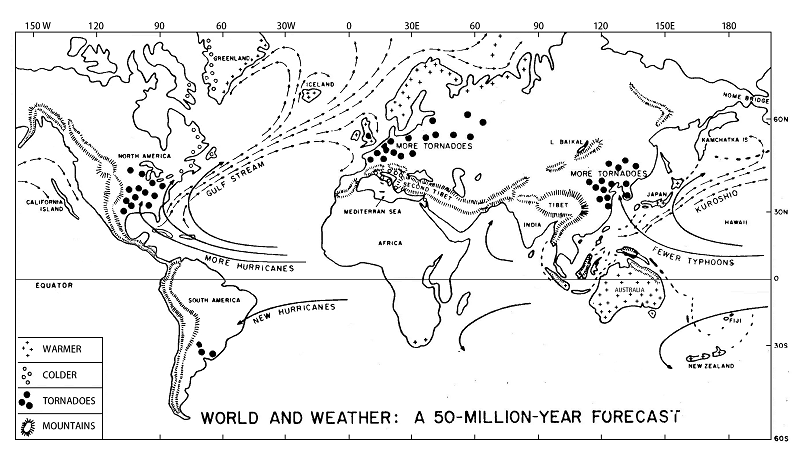 |
One rather well-known visualization was set forth by the famous British astronomer Sir James Jeans many decades ago. Imagine a penny carefully balanced atop the Washington Monument. Affixed to the cent is a postage stamp. Proportionately, the Monument represents the age of the Earth, the coin the entire age of the species of man, and the stamp the length of time since humans first learned to use tools.2109
Our minds are easily boggled. The whole history of the United States spans a mere two hundred years, a series of only eight generations of humankind. The differences between the late 18th century and the modern world seem immense. To contemplate our world as it may exist two hundred years hence sorely taxes our imagination (Figure 6.2).
But hundreds or even thousands of years are nothing to the xenologist.143 As biochemist and Nobelist George Wald aptly observes, "in geological time, even one million years is just a day.867 It is inconceivable that all other lifeforms throughout the Galaxy began evolving at exactly the same time as we, and at the same rate. If ETs do exist, many of them undoubtedly possess civilizations millions of years our senior — if not hundreds of millions or even billions of years more advanced.
|
Figure 6.3 Timescales of Responses to Change(from Wilson565) |
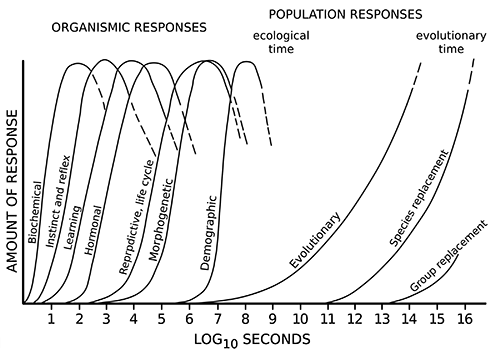 |
Before such numbing timescales, humanity pales into relative insignificance in view of the mission of intelligence in the cosmos. Even if mankind were to be virtually annihilated in some terrible natural catastrophe, over a span of millions of years other mammals might evolve to take up the niche vacated by ourselves. Considering the broad sweep of the evolution of sentience, there seems no reason to doubt that higher intelligence would reassert itself on this planet.
Barring such catastrophes, humanity and its progeny may have literally eons of life and development ahead of it.* The Age of Dinosaurs lasted only a hundred million years, roughly 0.2% the age of the Earth. Says Arthur C. Clarke: "If we last a tenth as long as the great reptiles which we sometimes speak of disparagingly as one of nature’s failures, we will have time enough to make our mark on countless worlds and suns."81
Part of our problem in understanding time is due to the differing order of change in nature (Figure 6.3). Humans are accustomed to dealing with events that can best be classified as "organismic responses" — instincts and reflexes, learning, cycles of reproduction and so forth.565 We are only now, in the 20th century, becoming dimly aware of the concept of ecological time, the scale upon which demographic (population) and ecospheric changes take place. And the next highest levels — of evolutionary and geological times — still remain beyond our ken.
* Ultimately, we are limited only by the lifetime of our sun. Another 8-10 billion years remain before it flickers and dies, although Earth will probably become uninhabitably hot in 4-5 eons.20, 2056 Perhaps by then, humanity will have discovered a new homeland.
One interesting example of a long-term trend is the change in the length of day. Every million years, because of tidal friction caused by the Moon, Earth’s day becomes about 3.3 minutes longer.2206 A couple hundred million years ago, during the Age of Dinosaurs, our planet revolved about one hour faster. In the steamy Carboniferous Period, when giant insects cruised forests of giant ferns, the day was only 22 hours long. One eon ago the components of Earth’s air were stabilizing near their present values and marine organisms were reeling with the discovery of sex. But they had to accomplish in only 18 hours what we take 24 to do.
Projecting into the future, a day in 1,000,000,000 A.D. will last about 30 hours. The Earth is gently slowing, a giant top marking time in eons.
"I perceived that I was on a little round grain of rock and metal," wrote Olaf Stapledon in his 1937 science fiction classic Star Maker,
filmed with water and with air, whirling in sunlight and darkness. And on the skin of that little grain all the swarms of men, generation by generation, had lived in labor and blindness, with intermittent joy and intermittent lucidity of spirit. And all their history, with its folk-wanderings, its empires, its philosophies, its proud sciences, its social revolutions, its increasing hunger for community, was but a flicker in one day of the lives of stars.1946
All of these considerations are of great significance to the origin of life on this planet. Until recently, scientists were of the opinion that the creation event itself might have taken place one or two eons after the formation of the Earth. But how much time was really required? As late as the middle of this century, no one really knew the answer to this question. The skeletal fossil record extends back only to the beginning of the Cambrian Period, about 600 million years ago. The Precambrian, comprising the first 87% of our world’s history, remained enshrouded in mystery and ambiguity.
In the last decade or two, improved techniques and several major finds have lifted the veil of ignorance. Scientists now hunt for molecular fossils, traces of the biochemical signatures left behind by the remains of microscopic organisms long dead.1420 The evidence now seems fairly clear that single-celled life existed some 3.4-3.6 billion years ago. (But note Schopf.2369) It is plausible that extremely primitive replicative lifeforms existed for several hundred million years prior to these earliest finds.41
|
We cannot even prove
that 10,000 years is too short a period. |
The implication is that life had half a billion years, perhaps even less, in which to assemble itself from nonliving chemical precursors. As two pioneers in abiogenesis research have noted:
There is no way at present to estimate when, during this (first) billion or so years, life arose. Periods of a hundred million years are so removed from our experience that we can have no feeling or judgement as to what is likely or unlikely, probable or improbable, within them. If the formation of the first living organism took only one million years, we would not be very surprised. We cannot even prove that 10,000 years is too short a period.521
The process of biological evolution must have begun as soon as the first living system emerged from the primieval "soup" four eons ago. Early forms of anaerobic photosynthesis probably arose three eons ago, in response to what one scientist has called "the world’s first energy crisis." Energy-laden molecules floating in the seas had become depleted. Photosynthesis allowed organisms to directly tap the power of the sun, which partially solved the crisis.
Unicellular life began to diversify about 2.3 billion years after the formation of the Earth, with the appearance of the first metazoans (multicellular animals).939 Aerobic photosynthesis was invented a short while later, and the concentration of oxygen — a harmful, poisonous waste product detrimental to most lifeforms in existence at the time — rose dramatically. In response to this "smog crisis," nature invented organisms able to consume the harmful oxidant and return carbon dioxide, thus detoxifying the air. These efforts were not entirely successful, however: Burning oxygen proved more efficient and made possible the conquest of land.
| Man - footnote to history |
Perhaps the vastness of time and our place in it can best be illustrated by the chronology in Table 6.1. Earth’s biography is plotted as a series of slow, painstaking steps from the formation of our planet 4600 million years ago up through the present. Truly, man is a mere footnote to history.
|
Our descendants …
will see our present age as the misty morning of human history. |
Sir James Jeans gracefully surmounts the barriers of temporal chauvinism:
We are living at the very beginning of time. We have come into being in the fresh glory of the dawn, and a day of almost unthinkable length stretches before us with unimaginable opportunities for accomplishment. Our descendants of far-off ages, looking down this long vista of time from the other end, will see our present age as the misty morning of human history. Our contemporaries of today will appear as dim, heroic figures who fought their way through jungles of ignorance, error and superstition to discover truth.2109
Opens (Mys) |
Characteristics |
and Climate |
(hrs) |
Midlatitude Lifeforms |
Life and Major Events |
||
|
4600
|
Azoic (~1000 Mys) |
H2 CH4, NH3, H2O (N2 CO, HCl, H2S trace constituents) |
Formation and consolidation of planet Earth |
||||
|
4500
|
(~2100 Mys) |
Primitive prebiotic chemical evolution |
|||||
|
4400
|
Atmosphere very highly reducing |
||||||
|
4300
|
|||||||
|
4200
|
Differentiation; solidification & stabilization of the crust |
||||||
|
4100
|
* * Origin Of Life * * * |
||||||
|
4000
|
Atmosphere strongly reducing |
Oceans filled to 10% their present volume |
|||||
|
3900
|
|||||||
|
3800
|
Great volcanic activity, granite intrusions, some sedimentary deposition, and extensive erosion |
||||||
|
3700
|
Great increase in N2 production |
||||||
|
3600
|
(~1100 Mys) |
H2 CH4, NH3, N2 (CO2, H2O, HCN, H2S as trace constituents) |
Graphites of possible |
Unicellular Life" |
|||
|
3500
|
|||||||
|
3400
|
Atmosphere less reducing |
||||||
|
3300
|
Oceans essentially filled | Onverwacht and Fig-Tree: Organisms resembling blue-green algae (chemical molecular fossils) Early protozoans |
Nonoxygenic photosynthesis | ||||
|
3200
|
CO2 rises to 1% of total atmospheric composition; H2 vanishes |
||||||
|
3100
|
First limestone deposits | Microfossils and bacteria | |||||
|
3000
|
|||||||
|
2900
|
Atmosphere slightly reducing neutralized |
Bulawayan Group, South Rhodesian limestones |
|||||
|
2800
|
|||||||
|
2700
|
Soudan Shale microfossils | ||||||
|
2600
|
|||||||
|
2500
|
(~300 Mys) |
N2, CO2 (NH3, CH3, H2O, O2 as trace constituents) |
Wealth of evidence of biological activity Strikingly advanced flora, Macro-fossils remain rare |
Primitive Marine Invertebrates" |
|||
|
2400
|
PRECAMBRIAN (300 Mys) |
||||||
|
2300
|
|||||||
|
2200
|
(~120 Mys) |
. | |||||
|
2100
|
PRECAMBRIAN (~600 Mys) |
Atmosphere slightly oxidizing |
Witwatersrand Supergroup, South Africa (microbiota) |
||||
|
2000
|
Great sedimentation; sedimentary rocks extremely thick; repeated glaciations; extensive erosion |
Anaerobic and oxygenic life flourish, the former slowly giving way to the latter Gunflint Iron Formation (Canada): blue-green algae, flagellates, & fungi |
oxygenic photosynthesis |
||||
|
1900
|
O2 begins a dramatic rise CO2 drops to present level CH4, NH3 vanish |
||||||
|
1800
|
Some volcanic activity | ||||||
|
1700
|
Atmosphere oxidizing | ||||||
|
1600
|
Primitive aquatic plants, marine protozoa and aerobic metazoa |
||||||
|
1500 |
|||||||
|
1400
1300 1200 |
Atmosphere strongly oxidizing | ||||||
|
1000
900 |
(~400 Mys) |
N2 78% O2 21% Ar ~1% CO ~0.1% H2O (trace) Modern atmosphere established |
Bitter Springs: blue-green algae, red algae, fungi, dinophyceans Mollusks, worms, & other marine invertebrates (sponges, brachiopods) |
||||
|
800
|
|||||||
| Algonkian Ice Age | |||||||
|
700
|
All animal & plant phyla established |
Higher invertebrates" |
|||||
|
600
|
(~375 Mys) |
Cambrian (100) | Climate warm; formation of major Paleozoic geosynclines |
Spores, tracheids Trilobites and brachiopods dominant Spread of land plants Freshwater fish, coral, Marine arachnids |
|||
|
500
|
Ordovician (75) | Low continents; warm Arctic; extensive land submergence & flooding |
Vertebrates |
||||
|
400
|
Silurian (25) |
Eocambrian Ice Age |
Wingless insects; amphibians, lungfishes, First reptiles |
||||
|
300
|
Permian (50) | Climate warm & humid at first, cooler later |
Giant ferns, cool swamps Large insects, thernlonts |
Insects and Amphibians" |
|||
|
200
|
(~150 Mys) |
Triassic (50) | Dry and cool; continental uplifting, Pangea breakup |
Modern insects First dinosaurs First mammals |
|||
|
Jurassic (50) |
Climate warm, last widespread flooding, shallow inland seas; Alps, Andes, Himalayas, Rockies rose |
Giant dinosaurs, toothed birds Dinosaurs decline; first flowering plants |
|||||
|
100
|
(~75 Mys) |
Tertiary (75) | Climate cooler Quaternary Ice Age (repeated global glaciation) |
Rise of birds, higher mammals, and arthropoids (including the genus Homo) |
|||
| Quaternary (1) | |||||||
 Anthropologists jokingly tell of two cannibals watching an airplane fly overhead. Eyeing the craft wistfully, one says to the other, "It’s very much like lobster. It’s hard to get into, but very good once you get inside."
Anthropologists jokingly tell of two cannibals watching an airplane fly overhead. Eyeing the craft wistfully, one says to the other, "It’s very much like lobster. It’s hard to get into, but very good once you get inside."
Kenneth Boulding, Director of the Institute of Behavioral Science at the University of Colorado, insists that the cars, planes and factories which surround us bear an analogous relation to the life inhabiting them as the lobster’s shell does to the lobster. "If a being from outer space were observing this planet," Boulding suggests, "he might well report that the process of evolution had produced a species of large four-wheeled bugs with soft, detachable brains."30
How can we accurately differentiate the living from the nonliving? For years, science fiction writers have been teasing our imaginations, giving us stories about plants that act like animals,564, 2115 animals that act like plants,607, 2168 and other organisms that almost defy classification.1561, 2163, 2210, 2221 Countless stories have been written around the theme of "machine life,"983, 1755, 1836, 1912 and a well-known Stanford radioastronomer has speculated that there may exist aliens which are simply spherical balls. Instead of handling objects as we do, Dr. Ronald Bracewell suggests that "they might have to ingurgitate them and manipulate them as we can manipulate things with our tongues. Perhaps their tongues would be luminescent and there would be an eye in the roof of their mouth, or a microscope."1040
Science fictioneers have devoted a great deal of time to an attempt to identify some of the problems we may encounter simply in recognizing that an object on another world is alive. False calls in either direction are possible. We may, for instance, mistakenly ascribe life to what is in reality a purely physical process. Conversely, there is the more frightening possibility that we might fail to identify a fascinating but unusual lifeform, which could cause irreparable harm before the error was discovered.
|
Hypothetical organisms
|
| Polymorph |
Such hypothetical organisms generally fall into five broad categories (although there are numerous exceptions). First we have the polymorph, a creature having a plural or changeable form. In Olaf Stapledon’s First and Last Men, Earth is invaded by a host of microscopic organisms from Mars. On occasion, these microbes form themselves into a rational entity by solidifying as a kind of "intelligent cloud."81 Such is not without precedent even on Earth: It has long been debated whether the sponge (Porifera) is a true organism or a colony of unicellular organisms.443
| Lithomorphs |
Ralph Milne Farley wrote "Liquid Life" back in 1936, in which a virus in a pond achieves group-collective consciousness.581 This is similar to the "scum-intelligence" proposed by Bracewell80 or the "mold-intelligence" proposed by Academician A. Kolmogorov, a Soviet writer.1330 Perhaps easier to view as living but equally difficult to understand are Arthur Clarke’s Palladorians, each of which is described as possessing "no identity of its own, being merely a mobile but still dependent cell in the consciousness of its race."2207 Another class of exotic fictional lifeforms are the lithomorphs, organisms having the form of rock. Such creatures have actually been discussed in sober scientific circles.1238 The two extremes of the problem of false calls are nicely illustrated by a pair of science fiction tales involving lithomorphs.
The Star Trek episode entitled "Devil in the Dark" deals with the discovery of a silicon-based organism that lives in the rocky mantle of a small planetoid. The human miners had been collecting and destroying apparently useless spherical silicon nodules — which turned out to be the Horta’s eggs. In Clarke’s novel Imperial Earth, exactly the opposite difficulty is encountered. Early settlers on Titan, the largest moon of Saturn, discover the "waxworms," entities snaking around on the surface at speeds up to fifty kilometers per hour and often pausing to climb over hills. "To the bitter disappointment of the exobiologists," Clarke writes, "they had turned out to be a purely natural phenomenon…"1947
| Macromorphs |
Macromorphs are beings having a large or elongated distribution. Typical of this class is the huge single-cell lifeform encountered in the Star Trek adventure "Immunity Syndrome," or the Gaia concept of the living planet sponsored by scientists Margulis and Lovecock.1293
Perhaps the most fascinating suggestion along these lines was made by the Swedish writer Gosta Ehrensvärd, who pointed out that organisms in the sense we understand may not even be a prerequisite for life.257 As an example, he envisions a coordinated network of lakes and streams covering a planet, participating in a complementary carbon cycle together with a sun-activated circum-planetary flow of water. Such a system, Ehrensvärd claims, "would undeniably constitute life, but it would hardly correspond to our idea of organism life. We could hardly recognize at first that we were dealing with something living, for we would not see any mass, body, or anything moving, but only a global activity in chemical serenity."
| Amorphs |
The fourth class of unusual creatures are the amorphs, those entities which exist without form or shape. Perhaps the best-known amorph is from the 1958 Paramount Studios movie "The Blob," the story line of which will not be gone into here. Suffice it to say that such organisms are not wholly without precedent on Earth. Slime molds are acellular plants which, because their construction is not unlike a sheet of water, find it possible to slowly creep about on the ground.
| Plantimals |
Blobs could also arise by natural evolution from Euglena ancestors (a photosynthetic microbial animal), or by artificial evolution as a direct consequence of genetic experimentation with "plantimal" cells. Plantimals are created by fusing animal cells with plant cells to form viable interkingdom protoplasts. To date, human tissues have been mated with carrot and with tobacco cells, and rooster cells have been joined with tobacco as well. According to Dr. James X. Hartmann of Florida Atlantic University at Boca Raton, a living, meatlike amorph might eventually be grown as livestock which could build animal protein by converting the sun’s energy directly into chemical energy — just as plants do.1617
|
There have been many variants on this theme in science fiction,1389 including petroleum-blobs such as in Brenda Pierce’s "Crazy Oil" on Venus.2071 In a familiar plot line, the human miners discover too late that the sticky black goo they’ve been extracting is part of a living organism. Still more fascinating is the possibility of superfluid amorphs, such as those described by Larry Niven in his "The Coldest Place":
| Electromorphs |
Finally, we have the electromorphs — beings having the form of electronic energy, fields or plasmas. These ethereal creatures, first described by the Russian space pioneer K. E. Tsiolkovsky445 and later given a more public airing in the Kubrick-Clarke masterpiece 2001: A Space Odyssey,1912 are among the most beloved of science fiction writers. Hal Clement notes that "one must admit that very complex electric and magnetic field structures other than those supplied ready-formed by atoms and molecules are conceivable."878 One of the first science fiction novels the author ever read, decades ago, was about a form of intelligent ball lightning inhabiting the planet Mercury.*
Arthur Clarke has warned that we might not even be able to detect the presence of an alien species on a planet, save by the use of sophisticated electronic gadgetry. The lifeform could be gaseous, electronic, or could operate on timescales far faster or slower than our own.81 Hal Clement has fictionally created creatures constructed of densely packed electrons possessing quasi-solid properties and which live inside suns,2139 and still others that inhabit neutron stars, existing in a kind of superoptic quantum space and feeding directly on patterns and structures of information.2183
The classic electromorph of all time remains, however, astronomer Fred Hoyle’s Black Cloud — a kind of intelligent comet.62 (Being a lifeform of the dimensions of a solar system, it is also a macromorph.) In the novel, a great patch of ionized gas, which enters our solar system and engulfs Sol, is found to be alive when efforts to predict its movements using the simple laws of mechanics fail. Says the astronomer-protagonist in The Black Cloud: "All our mistakes have a certain hallmark about them. They’re just the sort of mistake that it’d be natural to make if instead of the Cloud being inanimate, it were alive."
It turns out that the biochemistry of this amazing organism is plasma physics instead of molecular chemistry. Memory and intelligence are stored on a conductive substrate of various solid materials, and are controlled, operated and manipulated purely by means of electromagnetic forces. Ionized gases carry substances to wherever they are needed, like a bloodstream. The Cloud must therefore be recognized as alive, at least in the sense of possessing intricate structures, a capacity for regeneration and energy utilization, and a complex behavior.
* I have since forgotten the title, which annoys me greatly. (Note added, 2 Jan 2011: Erik van Lhin (aka. Lester del Rey), Battle on Mercury, The John C. Winston Company, Philadelphia PA, 1953.)
 The possibility of discovering an exotic lifeform such as the above has spurred biologists to carefully reconsider their assessment of the nature of life. Scores of situations can easily be conjured up in which our tried-and true common sense rules break down horribly. The need for a more rigorous definition is clear.
The possibility of discovering an exotic lifeform such as the above has spurred biologists to carefully reconsider their assessment of the nature of life. Scores of situations can easily be conjured up in which our tried-and true common sense rules break down horribly. The need for a more rigorous definition is clear.
If so many different kinds of life are possible, though, can we hope to reach them all with a single definition? Perhaps. For instance, one comprehensive characterization of life, at once exact and unsatisfying, might be: "Life is a highly improbable state of matter."1171 The difficulty arises when we try to be a bit more specific than this.
Some of the most generalized functional definitions have been rather ingenious. One author presents an ecological specification: A rock has small influence on another rock, but an organism profoundly affects all other living things around it. Living creatures alone can form ecological systems.64 Dr. Daniel Mazia has suggested that survival is the key to understanding what life is. As he correctly points out,
the living world thwarts time by survival, all the rest combats time by endurance.313
Another writer, Dr. V.A. Firsoff, has proposed that "mind" underlies all life, but is a quality denied to the nonliving.352 Others would claim that "the exclusive property of life is consciousness"171 or "self-direction."444 Still another definition hinges on the similar concept of "free will." As the late John Campbell, former editor of Analog, once put it: "Inorganic matter displays the characteristic that what it can do, it must. Any nonliving system always does everything it can do. Living systems don’t display that characteristic; if a living organism can do something, it — may."200
|
Life's unique properties
|
The traditional biologist points out that all living things possess certain unique properties. One way to define life rigorously is in terms of specific, enumerated traits: Growth, feeding and metabolism, motility (physical movement), responsiveness to environmental stimuli, and reproduction with adaptation.
Let’s look at each of these in turn.
During the process of growth, a living organism takes in raw materials and integrates them into itself. Molecules of various substances are added, redistributed, or removed as the body changes shape and develops new structures. Growth also allows for replacement of old worn-out parts.
Unfortunately, many non-living systems also display growth. Crystals of table salt, for instance, or hailstones can be said to grow.
|
Reproduction is probably
the most frequently cited "essential" defining characteristic of living systems. |
"Chemical gardens," made from heavy metal salts immersed in a bath of sodium silicate solution, also exhibit growth. It is true that most of these counterexamples involve only simple accretion from the outside, and the structure remains basically unchanged. But the flame of a candle appears to grow, and in a fire there is an actual throughput of new atoms. Hence, the candle flame is a valid exception to growth as a defining characteristic of life.
How about the criteria of feeding and metabolism? We know that living organisms eat primarily for two reasons. First, food is ingested and metabolized to provide an energy exchange with the surrounding medium. This gives a lifeform the ability to carry out any other functions it may wish to perform — reproduction, movement, thinking, more eating, etc.
Second, food must be accumulated to secure the raw materials necessary to effect repairs and to maintain growth. As has been pointed out, the kind of food consumed is really irrelevant. While humans and worms may prefer apples, some bacteria thrive on the most putrefactious sewage (and abhor oxygen), and plants "eat" carbon dioxide and sunlight.
But here again we note that the candle flame has a kind of metabolism. Fires may be said to digest their fuel and to leave wastes behind as chemical energy is converted to heat. Crystals too may eat, if we are willing to consider the saturated chemical solution in which they grow to be their food. Even machines metabolize their fuel, whether to manufacture spare parts or to build near-duplicates of themselves.
Motility is another oft-touted characteristic of life: Animals, and plants to a lesser extent, are capable of bodily movement. Yet there are many analogues in the world of the nonliving. Rocks and snow move in avalanches, cars travel highways, rivers flow, and under the proper thermal conditions metals will expand and contract. Granted, most of these are the result of the imposition of strictly external forces.444 Nevertheless, the fact that forest fires may spread under their own power constitutes an exception to the motility rule.
What about irritability? It has been said that if organisms are to profit from their association with the environment, they must be responsive to it at all times. Sensors and effectors thus become more and more highly developed as we climb the evolutionary ladder.
However, some non-motile bacteria show little evidence of reaction to stimuli,64 and plants are notorious laggard in their responses. Also, irritability is a property demonstrated by many nonliving systems. Crystals react quite sharply to changes in the solute concentration or temperature of their environment. The candle flame recoils when an open door admits a draft. A flask of nitroglycerine is highly responsive to certain environmental stimuli, particularly heat and shock.881
Reproduction is probably the most frequently cited "essential" defining characteristic of living systems.20, 521 Although a few scientists would demand the presence of DNA or RNA molecules, proteins, lipids, polysaccharides and the like as requirements for life, most stick to the basics: Replication plus adaptation.
According to these so-called "genetic" definitions of life, living things are entities capable of reproducing themselves, mutating, and subsequently re-reproducing the new mutated form. Organisms are required to multiply geometrically as well. Simple arithmetic reproduction, as in a printing press, is insufficient. The copies themselves must also be able to make more copies. When mutations arise, they are faithfully duplicated — variation is preserved in subsequent replications.
The central idea behind this attempt to define life by reproduction is that living organisms must be the subjects of natural selection, capable of adaptation and evolution. Any system that can replicate, mutate, and replicate mutations will be susceptible to normal evolutionary processes. Favored organisms with the highest potential for survival go on to multiply; others who fare more poorly in the struggle for existence eventually become extinct. Fundamental to the genetic definition of life, then, is the built-in and perhaps unwarranted assumption that a certain level of complexity cannot be achieved save by natural selection operating via adaptive replication.2358
It is entirely possible that some lifeforms may have no need to reproduce themselves. Such nonreproducers, if they exist, must be either immortal or very recent arrivals. One class of such beings would be self-creating but nonreplicating organisms, such as robots capable of making continual repairs and of upgrading their own mechanisms periodically, or such as astronomer Hoyle’s Black Cloud mentioned earlier.
There could even exist beings who evolve by means of acquired characteristics.2216 Such lifeforms could neither die nor reproduce, but would instead modify their parts in response to the changing environment. As Dr. P.H.A. Sneath of Leicester University puts it: "Evolution and selection would then operate internally on their constitution, rather than on a succession of descendent organisms."64 Dr. Sneath suggests that the closest analogy to this might be soils, which don’t reproduce in the usual sense but are complexly organized systems nevertheless. Soils respond to environmental changes, arise wherever there is rock and wind to erode it, and are virtually immortal. Organisms such as these would be unable to "compete" with their neighbors without blending together with a total loss of individuality.
|
Most bees, ants, wasps and
termites don’t reproduce… |
There are other objections to the use of adaptive reproduction as the fundamental criterion for life. Mules, the offspring of a mare and a male donkey, are sterile and so technically are not "alive"- under the genetic definition. Most bees, ants, wasps and termites don’t reproduce either. Selection acts on the whole nest, rather than on individual units, so evolution proceeds through the queen and drones alone. Many varieties of hybrid flowering plants are similarly sterile.
The inorganic world too is rife with exceptions. Flames, driven by wind or with sparks, can reproduce and "mutate." Crystals placed in solutions doped with foreign ions are perfectly capable of reproduction, mutation, and of propagating the mutation (i.e., lattice imperfections).
We see that traditional concepts of life are unduly restrictive for our purposes. As Dr. Mazia laments: "The problem is not that our conception of a living thing is vague; on the contrary, our concern is that it is too definite because it is too provincial."313 We must seek more generalized means to identify and to define life.
| Complex interrelatedness |
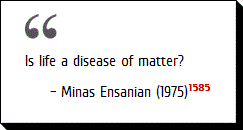 Life is a process by which relatively unorganized environmental components are made more organized. That is to say, life is a building up-process, although to organize also means to cut down the possibilities. But certainly a basic characteristic of all lifeforms is that they are highly organized.2214
Life is a process by which relatively unorganized environmental components are made more organized. That is to say, life is a building up-process, although to organize also means to cut down the possibilities. But certainly a basic characteristic of all lifeforms is that they are highly organized.2214
What do we mean by "organization"? The concept may be viewed in terms of what Sneath has called "complex interrelatedness.64
Interrelatedness means simply that all parts of the pattern are related to and somehow affect all other parts. Each component reacts to changes in its surroundings so as to preserve internal integrity and minimize the effects of any disturbances. This damping action is the principle of homeostasis, common among biological systems. Of course, biochemical homeostasis can be preserved only within certain critical tolerance limits. Death will rapidly overtake any system which is subject to stresses it cannot tolerate.
Complexity is the other facet of organization.64, 1643 "Complex" is used here in its normal sense, as opposed to "simple." Candle flames have a great deal of interrelatedness, yet they lack complexity and hence "organization" as well. Conversely, a lump of granite is highly complex, but because it lacks interrelatedness it cannot be considered "organized" in the sense of having life.
|
The key to life
may well be information itself. |
Dr. Sneath cites a most useful example of the role of complexity. If complexity is defined as the amount of information needed to completely characterize a system, the perplexing case of the growing crystal is greatly simplified. We might describe a small cube of rock salt as follows: "A simple-cubic Bravais crystal lattice structure with spacing of 2.82 × 10-8 cm, consisting of alternating sodium and chlorine atoms, containing a total of 1020 atoms of each kind." This requires only a few lines of print, and is complete.
On the other hand, living things are typically characterized by enormously more complicated descriptions. Life systems possess order on a scale far smaller than the macroscopic. Unlike the monotonous repetitiveness of the salt crystal, even the simplest bacterium needs some 103-104 different enzymes, each with a unique sequence of perhaps a hundred or so amino acids.64, 630 This is real complexity. On the microscopic level, life might best be characterized as a highly "aperiodic crystal."2213, 2364
The key to life may well be information itself. The living world is built from the stuff of the nonliving world, different only in its complexity and organization. Organisms find it possible to actually store and replicate the information that specifies their organization.
Yet it is purely capricious to set some arbitrary level of complexity as the threshold of life.1717 A frozen amoeba, for example, has an amazingly detailed and intricate structure without being alive — it has only the potential for life. Organization, as we shall see presently, is a most useful parameter for assessing the intensity or efficiency of life. However, it is more reasonable to base our definition on the fundamental processes and functions displayed uniquely by living systems.
|
Entropy:
|
Thermodynamic and statistical principles are among the most fruitful tools of scientific inquiry. They are equally applicable to simple and to complex systems, living or nonliving, terrestrial or extraterrestrial. As Dr. James P. Wesley, Associate Professor of Physics at the University of Missouri in Rolla, tells us:
The relationship of life to the environment is, above all, a thermodynamic relationship. Wherever man may go and whatever alien lifeforms he may encounter, the thermodynamic behavior of life will always be basically predictable.1717
The idea of entropy is often involved in modern discussions of the definition of life.
What is entropy? There are really two relatively straightforward aspects of this concept. The first ties in to the thermodynamic aspects of matter, having to do with heat and energy; the second pertains to statistics and order in any system.
Entropy in the thermodynamic sense is a distinct, physically measurable quantity, much like length, temperature, or weight. At a temperature of absolute zero, to take one example, the entropy in a lump of matter is exactly zero. If the temperature is slowly increased in tiny, reversible little steps, the increase in entropy is mathematically equal to the amount of energy (in joules) divided by the temperature at which it was supplied. This holds even if a change of state occurs, as from solid to liquid.
Suppose that we melt a cube of solid ice at 0 °C. If the mass is 1 kg, the increase in entropy can be calculated as exactly 1223 joules/degree. Entropy in the thermodynamic sense is thus a very real, physical quantity.
In the statistical sense, entropy is a measure of the disorderliness of a system. It seems rather clear that when we melt our 1 kg block of ice, the neat orderly arrangement of water molecules in the cube is destroyed. The rigid crystal lattice is converted into a less ordered system — the continually changing, sloshing, randomized distribution of molecules in a liquid.
When the orderliness of a system decreases, the entropy correspondingly increases. The situation is analogous to the state of the public library when the shelvers are out on strike. Books are removed from their proper places but are not returned. Disorder and randomness — entropy — increase.
The greater the structural complexity of a system, the more information is required to describe it. The more organization a system has, the more information and the less entropy it possesses. But information and orderliness, on the one hand, and entropy, on the other hand, are irreconcilable.
|
It is the business of the
universe to destroy complexity and to become progressively more randomized. |
The Second Law of Thermodynamics states that entropy and disorder shall always increase and that information will naturally tend to be degraded and lost in any isolated physical system. (Such isolated systems drift from less probable states to more probable ones.) It is the business of the universe to destroy complexity and to become progressively more randomized.
How does this relate to life? Organisms appear to present a rather curious thermodynamic anomaly. Living systems "violate" the Second Law, by developing well-ordered systems (themselves) out of relatively chaotic systems (their food).85 At first blush, lifeforms seemingly oppose the "universal drive to disorder" mandated by thermodynamic principles. They organize their surroundings and produce order where there was little or none before. Entropy is actually reduced.
This apparent conflict has only been resolved in the last decade or so. Classical treatments dealt with idealized, isolated systems which transfer no energy or matter between themselves and the external environment.2213 In sharp contrast, most systems in nature are nonisolated "open" systems, exchanging matter and energy with the surroundings.
|
Energy emerges from the source,
flows to the sink, and is there absorbed. |
Energy by itself is not enough — there must be a useful flow of it. This means that to support life, an environment must possess both a "source" and a "sink." Energy emerges from the source, flows to the sink, and is there absorbed.
Living systems customarily establish themselves as intermediate systems, interposed between some source and some sink in the environment. Then, they utilize the energy flow from source to sink to power their own internal functions.
The total entropy of the entire system, which we shall label E, is the sum of the entropies generated in two separate places. First, there is the entropy caused by the source-to-sink energy flow which we shall call S. Then there is the entropy generated by the intermediate system (the living organism) due to exchanges of matter and energy with the surroundings. If we call this L, then we know that the change in total entropy DE = DS + DL.
The second Law of Thermodynamics demands that the total entropy E of any isolated system always increase. Hence, the amount of change must always be positive, so DE > 0. The flow of energy from source to sink (S) consists of irreversible processes, so it too must always cause entropy to increase: DS > 0. Consequently, -DL < DS is our only constraint.
|
Negentrophy: Local pockets of negative entropy change. |
What does this mean in plain English? The last equation above simply says that while the entropy of a living system is always permitted to increase by the Second Law (e.g., upon death), a short range of decrease is allowed as well. That is, it is thermodynamically permissible to have local pockets of negative entropy change — "negentropy."
|
… the essence of life is
that it feeds on negentropy. against increasing entropy. |
Dr. Erwin Schroedinger was really the first to point out that the essence of life is that it feeds on negentropy.1678 An organism able to transfer disorder from itself to its environment can reach a plateau for which the steady-state entropy within the living system is less than the formal entropy entering it.85 Life involves a continuing struggle against increasing entropy.
Living systems thus increase local order at the expense of a larger decrease in order within the environment.
Does life really violate the Second Law of Thermodynamics? We’ve seen that organisms can effect a local decrease in entropy by maintaining an energy flow.* This leads to an ordering of the intermediate (living) system. So the Second Law does not hold for nonisolated systems (L), but only for isolated ones (E). It is invalid for lifeforms alone, but does hold if that same living system is considered in conjunction with the medium in which it is immersed.
Life by itself is a nonisolated system capable of achieving negentropic conditions locally. Life plus environment is an isolated system, for which the total amount of entropy must always increase.
As one writer puts it:
|
* A probable corollary is the necessity for "phase separation." In some sense, the sources and sinks should be physically separated with the living system inserted between them. So we expect barriers to exist between an organism’s sources and its sinks. This prevents dissipation of the system, protects it from adverse changes in the environment, and insures the lifeform’s ability to exert and maintain control over its interior.2213 The exact nature of these barriers — whether gravitational, electromagnetic, or utilizing some hitherto unsuspected principle — has not been widely discussed.64
|
It is the business of life to accumulate
information and complexity. |
At the most fundamental level, negentropic ordering processes are achieved by living organisms. Life drives its environment to physical or chemical disequilibrium, establishing an entropy gradient between itself and its surroundings.1144 All living systems possess this feature, and it is contended that any system engaging in such negentropic operations must be considered "living" to a certain extent (Figure 6.4).
The question is, of course, to what extent?
Rather than viewing the question of life in absolutist terms, it seems more fruitful to establish the intensity of negentropic processes as a measure of the extent of the life-quality. One of the more fundamental distinctions between "life" and "nonlife" is the degree of organization and internal structure possessed by living systems. Order and structure are virtually synonymous with information content.1012
That is, living systems do more than merely establish a thermodynamic entropy gradient — they establish an organizational / informational gradient as well. As organisms feed on negentropy, they in effect remove information from the surrounding medium and store it within themselves. It is the business of life to accumulate information and complexity.
|
“It is the business of life
to accumulate information and complexity.” |
In a physical sense, these data bits which permeate all lifeforms may be thought of as being stored in an "aperiodic crystal" — a biological lattice with highly irregular small-scale nonuniformities.2213 The more effective the negentropic processes, the greater the organization which will arise and hence the more aperiodic the physical structure will become. Organization is maintained by the extraction of order from the environment.
If we consider every "autonegentropic" system to be alive, then its character or richness of expression may be defined along a spectrum from lesser to greater levels of organization. At one extreme are the viruses, which are not negentropic systems by themselves and thus cannot be considered alive in the absence of living hosts. At the other extreme are mules and bees, earlier rejected by the genetic definition of life because of their individual inability to reproduce. These animals are quite clearly auto negentropic systems possessing a vast degree of organization both in the macroscopic and microscopic realms. Thus they are not only "alive" (because they feed on negentropy to build internal complexity) but also "very alive" (because they are so internally complex).*
The refrigerator in my house technically should be considered a "live" system in the very broadest sense, as it is a well-defined intermediate system which uses an energy flow to decrease entropy within (the icebox gets colder, and well-ordered ice crystals collect on the freezer walls) at the expense of increasing the entropy in the external environment (the kitchen air gets warmer). Yet its organizational structure is minimal. Little information is stored, and there is only trivial interrelatedness even on the macroscopic scale. There is scant evidence of aperiodic crystal, no complexity at all on the microscopic stage. So the intensity of life in my refrigerator is negligibly small.
Note that "machine life" or "solid state life" per se is not ruled out. As machines become more and more sophisticated, complexity follows. Large-scale integrated circuits available today pack millions of components onto a tiny silicon wafer the size of a postage stamp. Under the microscope, significant aperiodicities have begun to appear in the latest generation of electronic devices. It is entirely possible that, in time, machines will evolve beyond the point of negligible life-quality. This is true, despite the fact that modern digital computers (which merely process data without adding any of it to their internal structure) are not yet alive at all.
* While evolution and the capacity to reproduce are of immense biological importance, a system need not be capable of reproduction for it to be classified as living.2213, 62
In conclusion, xenologists suspect that there are two fundamental properties any system must possess before it can be considered alive:
|
For those who prefer succinct and pithy definitions, the author would
like to offer the following as a starting point for further discussion: Life is negentropic and self-organizing aperiodic crystal. |
- First, it must be thermodynamically negentropic, establishing an entropy gradient between itself and the environment.
- Second, it must utilize the entropy gradient to create or to maintain structural order internally — that is, it must be autonegentropic or self-organizing.
Then there is the quality of organization, known as complex interrelatedness or aperiodic crystal, which reflects the intensity of the life process displayed by a given entity.
